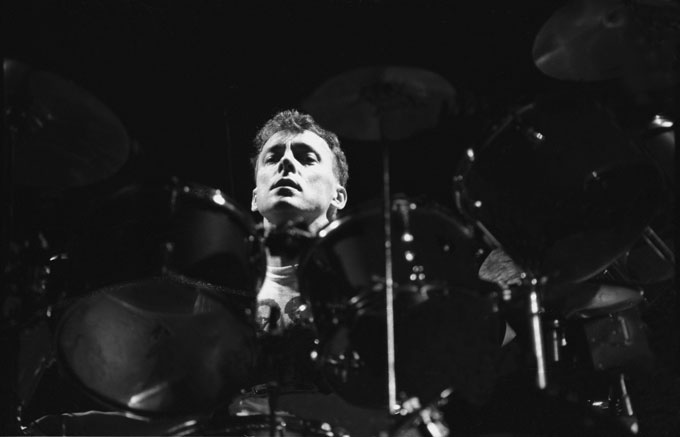
We may earn a commission from the affiliate links on this site. Learn more›
Today you’ll be learning about the most famous drum beats of all time! For beginner drummers, you can’t go wrong learning these tunes—so get scrolling!
Drums have been an integral part of music for centuries, and the beats and grooves drummers throughout history have created played a significant role in shaping the music we know and love today.
From classic rock to jazz, drums have driven the rhythm and provided the foundation for many iconic songs. This article will look at 11 of the most famous drum beats and grooves of all time and explore their impact on music history.
Click on the notation image to see it larger!
“We Will Rock You” – Queen
“We Will Rock You” by Queen has the most iconic drum beat on the list. The song’s rhythm, based on a simple stomp-stomp-clap pattern, was designed to be played by the audience during live performances.
Released in 1977 on News Of The World, the song quickly became a staple at sporting events and other public gatherings. The song’s groove is now considered one of the world’s most recognized and has been covered by countless artists in different styles.
Fun fact: there isn’t even a drummer playing on the track! All four band members recorded stomps and claps multiple times (the process of overdubbing) to give the song the thick and powerful groove we all know and love.
“Come Together” – The Beatles
The Beatles’ “Come Together” is another iconic song with a memorable drum beat. The song’s intro features two eighths on kick and hi-hat, followed by sixteenth note triplets on the hi-hat and down the toms. For that era of pop music, it was progressive. This section acts as a hook throughout the entire song. The verses then feature a simple but effective pattern that helps drive the song’s pace forward.
Come Together was released in 1969 as part of the band’s album “Abbey Road” and has since become one of the band’s most popular songs.
“Rosanna” – Toto
The drumbeat of “Rosanna” by Toto is one of the most recognizable beats in pop and rock history. The song was released in 1982 and quickly became a hit, reaching the top 5 on the Billboard Hot 100 chart.
The song’s half-time shuffle groove, which Jeff Porcaro famously plays, is a syncopated pattern combining funk and rock drumming elements, notably the Purdie Shuffle. In addition, Jeff introduces a pattern from the Bo Diddley beat to make it his own. Numerous drummers across many different genres have used this song’s groove. Thank you, Bernard and Bonham.
“Wipe Out” – The Surfaris
“Wipe Out” by The Surfaris is the most iconic surf rock song of all time, and its tom groove from the intro is infamous across middle schools around the world in band class.
The song was released in 1963 and quickly became a hit, reaching the top 5 on the Billboard Hot 100 chart. The song’s drumbeat, played by Ron Wilson, features accented sixteenth notes played on the rack tom at a quick tempo. Wipe Out was one of the first songs I learned to play as a kid—impressing my family and friends (despite being relatively simple to learn and play).
“Smells Like Teen Spirit” – Nirvana
The intro drum part of Nirvana’s “Smells Like Teen Spirit” is one of the most recognizable and influential in the history of rock drumming.
The song’s beat, played by Dave Grohl, features a powerful drum fill intro followed by a driving groove that helped to define the sound of the grunge movement.
Originally, Grohl wasn’t into the demo idea Kurt brought to the table, but after grinding away for more than an hour on the main riff, Dave created one of the most iconic drum intros and grooves of all time.
“I didn’t think much, to be honest. It was just another one of the jams we were doing” – Dave Grohl, Kerrang! 2002
“Smells Like Teen Spirit” was released in 1991 on Nevermind and quickly hit number 6 on the Billboard Hot 100 chart.
“Tom Sawyer” – Rush
The drum intro of “Tom Sawyer” by Rush showcases Neil Peart’s technical prowess—almost all new drummers want to learn how to play it at some point along their learning journey.
The intro features a driving sixteenth-note hi-hat groove that’s very challenging to learn for new drummers. Because of the way you need to open the hi-hat with the kick on different off-beats following the bass and guitar riff, it’s tough to make it groove as the Professor did in 1981.
The drum break after the 7/8 guitar solo section may be more iconic than the intro. I loved learning how to play that drum solo section with my nine toms from different drum sets.
“Tom Sawyer” was released in 1981 on Moving Pictures and quickly hit number 44 on the Billboard Hot 100 chart. The song still impacts modern artists, as Imagine Dragons played it live on one of their tours a few years back.
“Walk This Way” – Aerosmith
Since the song begins with drums only, it’s no surprise that “Walk This Way” is as memorable as it is. The song’s groove, played by Joey Kramer, is a powerful and driving pattern that helps to drive the song’s rhythm. It’s simple but highly effective.
The song was released in 1975 and quickly became a hit, reaching number 10 on the Billboard Hot 100 chart.
“Fool in the Rain” – Led Zeppelin
Like Rossana, “Fool in the Rain,” played by the legend John Bonham, also features a half-time shuffle inspired by Bernard Purdie’s Purdie Shuffle. It’s very similar, but Bonham drives the groove a bit harder, playing forward and adding an open hi-hat on the last triplet of beat one.
The groove showcases Bonham’s virtuosity and technical skill as a drummer, as well as his ability to play to the song. The song was released in 1979 as part of the band’s album “In Through The Out Door” and is of Zeppelin’s most popular songs.
“Hot for Teacher” – Van Halen
There’s a great debate on the internet about what Van Halen did in the intro for “Hot for Teacher.” Before the double bass drum part kicks in, it sounds like an engine idling.
Some say it’s a sample of Ed’s Lamborghini, some say it’s four-kick drums layered, and others theorize it’s Alex playing an old Simmons kick pad with sticks.
Maybe we’ll never know, but we know one thing for sure—”Hot For Teacher” has an iconic drum intro (and a brutal drum part to learn, courtesy of Alex Van Halen).
The song was released in 1984 and quickly became a hit, reaching number 36 on the Billboard Hot 100 chart.
“Sing, Sing, Sing” – Benny Goodman
Written by Louis Primo and performed by Benny Goodman and his orchestra in 1936, “Sing, Sing, Sing” is a classic Big Band tune known for the tom groove played by Gene Krupa.
The song’s upbeat arrangement and drive are largely attributed to Krupa’s drumming. His intricate percussive patterns lay the track’s foundation while constantly pushing it forward. In addition, the iconic tom groove emphasizes the dynamic rhythm of the song, inspiring countless drummers over the decades.
The song was released in 1937 and reached number 13 on the Billboard Hot 100 chart.
Released in 1959, “Take Five” features the most famous jazz drum intro. Written by Paul Desmond and performed by the Dave Brubeck Quartet, it’s renowned for its iconic groove by Joe Morello.
“Take Five” – Dave Brubeck Quartet
Morello’s playing has been credited with making the song what it is; he builds his part from a simple 5/4 swing pattern to an intricate display of syncopation and constantly varying rhythmic patterns. His improvisation is masterful yet subtle, propelling the song forward and giving it a driving energy that has kept listeners captivated for over 60 years.
Conclusion
These are just a few iconic drum beats and grooves that have shaped music history. From Queen’s “We Will Rock You” to Dave Brubeck Quartet’s “Take Five,” these beats have left an indelible mark on the music world and continue to be celebrated by drummers and fans alike.
Each of these beats has unique characteristics and has influenced the sound of their respective genres. Clearly, drummers have played a crucial role in shaping the music we know and love today, and their contributions should not be overlooked.
Another aspect to consider is the evolution of drumming, as technology and new instruments have created new sounds and beats.
For example, electronic drums, drum machines, and sample pads have allowed drummers to experiment and create unique grooves.
It’s also worth mentioning that drumming is broader than just rock, pop, and jazz. Drumming is essential to many different music genres, such as hip-hop, electronic, and world music.
Drum beats and grooves from these genres have also significantly impacted the music industry and have pushed the boundaries of what is considered “traditional” drumming.
These 11 grooves are just a tiny representation of the countless memorable beats created throughout history.
If you want complete transcriptions of these songs (plus hundreds more), check out Drumeo Edge. If you need more time to commit to a full membership, click here to get 100 free transcriptions of drumming’s biggest songs, plus playback tools for practicing (also read my review of Drumeo Edge—I highly recommend the program for new drummers).



